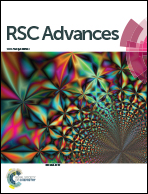Electronic structure and bandgap engineering of CdTe nanotubes and designing the CdTe nanotube–fullerene hybrid nanostructures for photovoltaic applications
Abstract
The electronic structure of CdTe nanotube–fullerene nanocomposites has been explored. Within this context, the structural and electronic properties of isolated 10![[1 with combining macron]](https://www.rsc.org/images/entities/char_0031_0304.gif) 0 faceted CdTe nanotubes (NTs) with hexagonal cross-sections were first investigated using the self-consistent-charge density-functional tight-binding (SCC-DFTB) method. The possibility of band gap engineering of clean CdTe nanotubes is explored by varying either the size or wall thickness of the NTs. However, the efficient modification of the band gap can be attained by introducing the molecular states of fullerene into the band gap region of the CdTe NTs. The effects of the modulation of the band alignment through the variation in the wall thickness of the CdTe NTs on the electron injection rate from the NT to C60 in hybrid systems have been explored and we also found that the light harvesting efficiency of these nanohybrids can be maximized by increasing the concentration of the C60–thiol moieties. The position of the electronic energy levels offers information about the electronic structure of the hybrid systems such as whether it constructs type I or type II hetero-junctions, which bears key information for their application in photovoltaics. We also studied the electronic structure of CdTe–fullerene hybrid nanostructures with a series of fullerenes of different compositions.
0 faceted CdTe nanotubes (NTs) with hexagonal cross-sections were first investigated using the self-consistent-charge density-functional tight-binding (SCC-DFTB) method. The possibility of band gap engineering of clean CdTe nanotubes is explored by varying either the size or wall thickness of the NTs. However, the efficient modification of the band gap can be attained by introducing the molecular states of fullerene into the band gap region of the CdTe NTs. The effects of the modulation of the band alignment through the variation in the wall thickness of the CdTe NTs on the electron injection rate from the NT to C60 in hybrid systems have been explored and we also found that the light harvesting efficiency of these nanohybrids can be maximized by increasing the concentration of the C60–thiol moieties. The position of the electronic energy levels offers information about the electronic structure of the hybrid systems such as whether it constructs type I or type II hetero-junctions, which bears key information for their application in photovoltaics. We also studied the electronic structure of CdTe–fullerene hybrid nanostructures with a series of fullerenes of different compositions.


 Please wait while we load your content...
Please wait while we load your content...